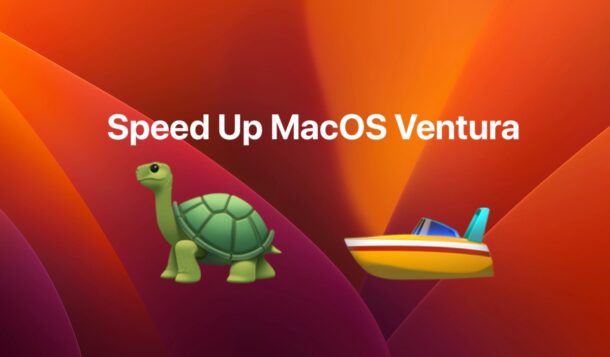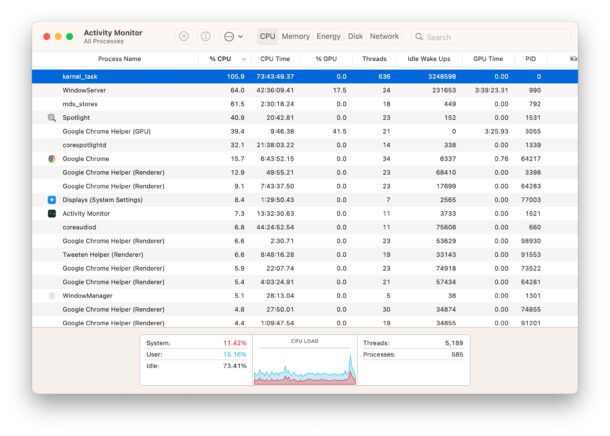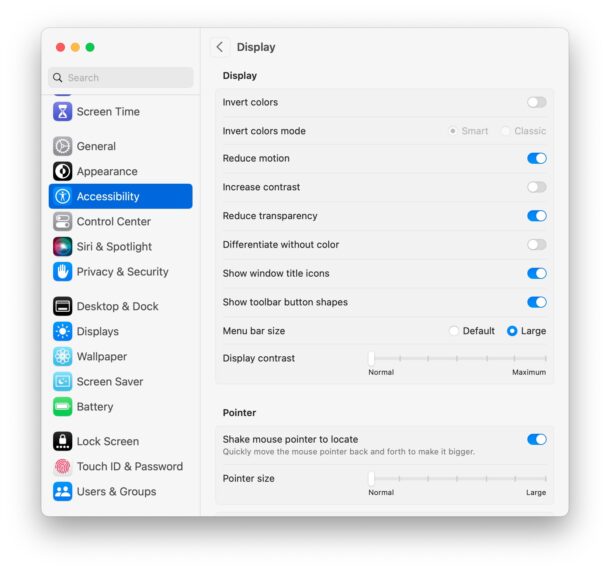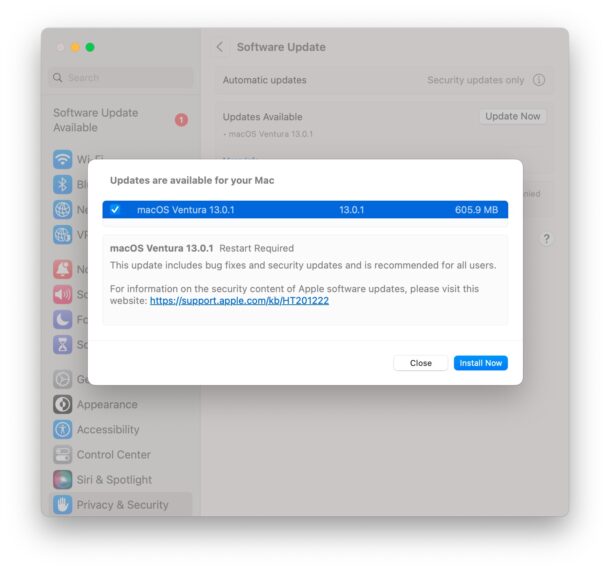[ad_1]

Some Mac users feel that macOS Ventura is much slower than macOS Monterey or Big Sur, offering generally poorer performance when performing the same tasks on their Mac.
It’s not unusual for users to feel that their computer is slower after a major MacOS upgrade, and Ventura is no exception. If you think your Mac is slower or sluggish, perhaps with slow app performance, more beach pads, or other unusually slow computer behavior, read on.
1: Mac is very slow after upgrading to MacOS Ventura
If the macOS Ventura update was recent, within the last few days or so, it’s likely that your Mac is slow because of background tasks and indexing. This happens with all major system software updates.
The best way to deal with slow performance after a major system software update like macOS Ventura is to leave your Mac powered on (if it’s a laptop) and powered on, and let it idle while you get on with life away from the computer. This allows the Mac to perform routine maintenance, indexing, and other tasks, and performance will return to normal when it’s done.
Usually, simply turning the Mac on and off overnight is enough to fix these types of problems after updating the system software.
2: Is Mac older? Limited RAM?
MacOS Ventura has stricter system requirements than previous macOS releases, and some users have noticed that MacOS Ventura runs more slowly on older Macs, or on Macs with more limited resources, such as insufficient RAM or disk space.
Generally speaking, any newer model Mac with 16GB of RAM or more and a nice fast SSD will run pretty well with MacOS Ventura. Macs with 8GB of RAM or less and slower-spinning hard drives can feel sluggish, especially when using many apps at once.
3: messages of the mind
The Messages app on the Mac is a lot of fun, but if you often exchange stickers and GIFs with people, having those Messages windows open can really slow down performance on your Mac if you let the Messages app use up resources to connect an animated GIF. or rendering of other Messages media content.
Simply turning off Messages when not in use, or even choosing a different message window that doesn’t have a lot of active media content, will help performance here.
4: Find resource heavy apps with Activity Monitor
Sometimes applications or processes that you wouldn’t expect to eat up CPU or RAM do so, causing your computer to slow down.
Open Activity Monitor on a Mac by pressing Command+Spacebar to bring up Spotlight, type “Activity Monitor” and press Return.
First, sort by CPU usage to see what’s using up your CPU. If something is open that isn’t being used and is using a ton of CPU, that app or process could be the reason your Mac feels slow.

If you see kernel_task constantly crashing, it’s likely that you have a lot of apps or browser tabs open and the kernel is swapping things in virtual memory.
WindowServer also often happens because there are a lot of active apps or media on the screen, we’ll get to that in a bit.
Google Chrome is a great web browser, but it’s notorious for using a lot of system resources like RAM and CPU, so if it has dozens of tabs or windows open, it can slow down performance on a Mac. Using a more resource-conservative browser like Safari can be a solution to this issue, or simply opening fewer windows and tabs in Chrome whenever possible.
More advanced users can also try force-quitting apps and processes that use a lot of CPU or RAM, but remember that force-closing apps may result in the loss of data in those apps, such as browser sessions or anything that isn’t saved.
You may also see processes that you don’t recognize but are taking up a lot of system resources, such as ApplicationsStorageExtension, which uses heavy resources to display “storage” usage data on your Mac, and simply closing this window will allow this process to unwind.
5: WindowServer heavy CPU usage and RAM consumption
You can see the “WindowServer” process using a lot of CPU and system memory. This is usually because you have too many windows or applications open on your Mac.
Closing windows, media windows, applications, browser tabs, and browser windows will allow WindowServer to remain.
You can help WindowServer use fewer resources by turning off transparency and visual effects on a Mac, but if you have dozens of apps and browser tabs open, it will still use a lot of system resources to draw those windows to the screen.
6: Turn off visual effects and eye candy like transparency and motion
Disabling visual eye candy on a Mac can help free up system resources so they aren’t used for visual effects.
- Open the Apple menu and go to “System Preferences”
- Select “Accessibility” settings
- Select “Display” settings
- Enable the “Reduce Motion” and “Reduce Opacity” switches

This will change the Mac’s visual appearance a bit too, usually with windows and title bars looking brighter and whiter than the lower grays and colors. But it should also use fewer system resources, potentially increasing performance.
Turning off transparency has been a trick for speeding up Macs for a long time, and it works especially well on older machines with generally less system resources.
7: Organize the Mac Desktop
If your Mac desktop looks like a disaster with hundreds of files, it can slow down performance on your Mac.
This is because every thumbnail and file on the desktop uses resources to draw on the screen, and so simply moving everything from the desktop to another folder and hiding them from view can instantly speed up your Mac using fewer resources.
Another option is to hide all icons on the Mac desktop, which basically turns off the desktop (but not the Finder), preventing you from seeing anything on the desktop. But for most users, simply moving everything from the desktop to a folder is enough.
8: Install macOS Ventura updates when available
Apple will continue to improve macOS Ventura and release software updates to the operating system, and you should install them when they become available, as they may fix bugs that can cause performance issues.
- From the Apple menu, go to “System Preferences”, then select “General” and go to “Software Update”.
- Install any available software updates for Ventura

9: Update your Mac applications
Don’t forget to update your Mac apps regularly, as they may be optimized for performance or fix bugs that affect performance.
The App Store is where you update many apps on your Mac at App Store > Updates
Some apps, such as Chrome, can update automatically or manually via the About Chrome menu item.
Install any and all available app updates for macOS Ventura, it’s still good system maintenance.
10: Is the Mac slow or the Wi-Fi / Internet slow?
Some users may experience slow wi-fi or internet connection issues, which means that when you try to browse the web or use web-based applications, everything is slower. But if that’s the case, the Mac itself might not be slow, it might just be the internet connection.
You can follow this guide to troubleshoot wi-fi and internet connection issues in macOS Ventura which may help you.
11: Why My Mac Often Beach Balls in Apps Slow App Performance
This is most likely a resource issue unrelated to macOS Ventura, so if you have other apps open that consume a lot of system resources, such as Google Chrome with tons of windows and tabs open, it can slow down the performance of other apps.
The easiest way to increase the performance of an application in such situations is to leave other applications that use a lot of system resources and free them.
12: Slow performance when previewing?
Performing simple tasks like rotating or resizing images in Preview on Mac used to be instant, but some users have reported that Preview on MacOS Ventura crashes, freezes, or takes minutes to complete, instead of seconds, such as Resize a large image. .
Like the beachball tips for regular apps, this is most likely a result of other apps using resources, so try skipping one or two apps that use heavy resources and then use Preview, it should speed things up.
13: Does Google Chrome feel slower on macOS Ventura?
Some users have reported that Google Chrome feels slower on MacOS Ventura.
If this applies to you, make sure to install any updates available for Google Chrome after you upgrade to macOS Ventura. It’s unlikely to be anything specific to Ventura, but it’s good practice to keep your firmware up to date.
Also, the easiest way to speed up Chrome is to close windows and tabs, which frees up a lot of memory and system resources.
–
Do you feel that performance in macOS Ventura is faster or slower than before? Did the tips above help you troubleshoot performance issues in macOS Ventura? Let us know your own experience with performance, speed and system slowdowns in the comments.
connected
[ad_2]
Source link

